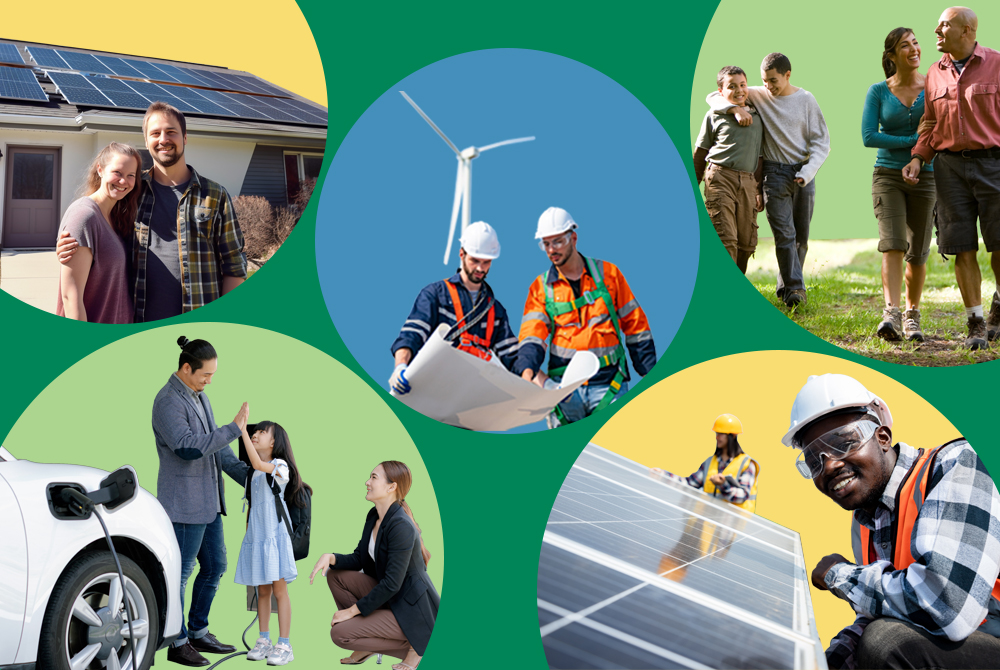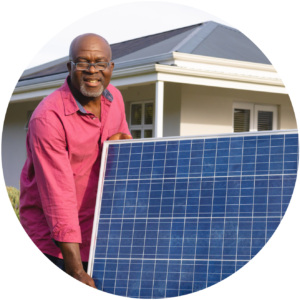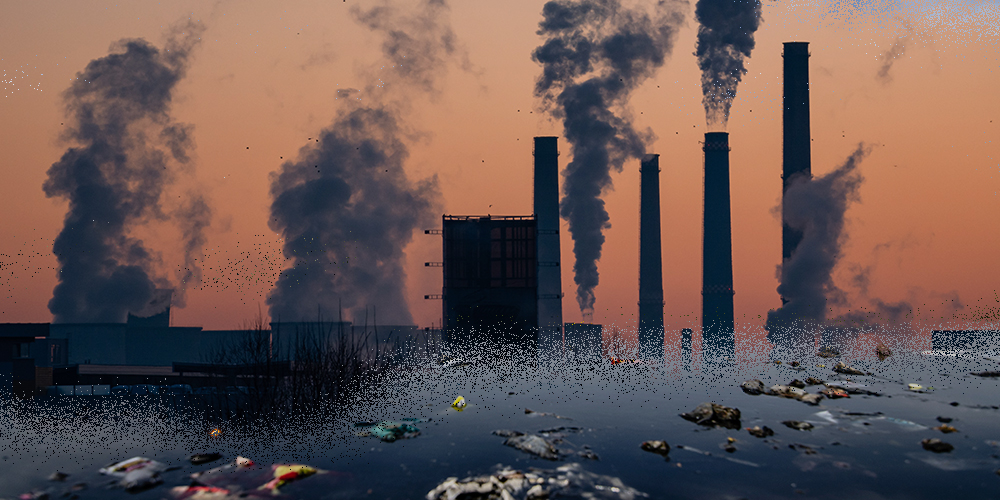Good Climate News this Week: Rules to Cut Pollution, an Offshore Wind Transmission Plan, Emissions Reduction in the EU, and More!
Apr 15, 2024

You’ve no doubt heard a lot about the Inflation Reduction Act (IRA) and LCV’s 18-month long nationwide campaign that helped push passage of the bill through Congress last year.
Though it took our movement more than a decade to enact transformative federal climate legislation, passing this historic federal clean energy plan was only the first step to advancing climate action and environmental justice.
Now, alongside our 30+ state affiliates in the Conservation Voters Movement and our partners, LCV is working to ensure that the plan is swiftly, effectively, and equitably implemented so that the IRA’s real-world benefits make their way to families, businesses, and communities across the country.
But what does “implementation” mean, exactly? Below, we share what IRA implementation is, why it’s the important next step after passage of the law, and what’s at stake if our movement doesn’t remain committed to defending and driving this process.
In this article:
The Inflation Reduction Act (IRA) includes roughly $370 billion in investments for climate solutions, clean energy, and environmental justice. These investments have the potential to put the U.S. on a path to reducing our greenhouse gas emissions by 50% by the year 2030 — but only if they’re put into action.
IRA implementation is the process by which federal government agencies — including the U.S. Departments of Treasury, Energy, the Environmental Protection Agency, and others — and state, local, and tribal governments establish and coordinate resources, personnel, and policies to distribute investments to businesses, non-profits, households, and other entities in a manner that is both timely and accessible and adheres to legislative text.
In plain terms: It’s how our nation decides to spend the money set aside to help lower energy costs for families, secure energy independence, and meet science-based climate goals to ensure a habitable planet for generations to come.
During this process, federal and state agencies ask for public input on the new policies and investments that they are tasked with implementing, providing critical opportunities to shape how investments will be distributed before finalized rules are in place.
These opportunities are time sensitive. The window to provide input is short, and the most compelling and influential input will be coordinated and consistent among:
It’s nearly impossible to overstate what’s at risk:
![]() Life as we know it. For starters, what’s at stake is humanity’s ability to sustain life on this planet. (Heavy, we know, but also true.)
Life as we know it. For starters, what’s at stake is humanity’s ability to sustain life on this planet. (Heavy, we know, but also true.)
The historic climate investments in the Inflation Reduction Act provide a once-in-a-generation opportunity to put the U.S. on a path to reducing our greenhouse emissions by 50% by 2030. As the country with the largest cumulative greenhouse gas emissions in the world, this reduction would have a dramatic impact on world emissions overall and set an example for other nations to follow.
![]() Our health. Similarly, if we don’t effectively or fully use the investments in the IRA, we would be passing up the opportunity to create communities with clean air to breathe, clean water to drink, and a drastic reduction in health-related impacts of climate change and fossil fuel pollution.
Our health. Similarly, if we don’t effectively or fully use the investments in the IRA, we would be passing up the opportunity to create communities with clean air to breathe, clean water to drink, and a drastic reduction in health-related impacts of climate change and fossil fuel pollution.
![]() Economic prosperity. Also at stake is a missed opportunity to create millions of good-paying jobs through new technologies, green manufacturing, and clean energy industries like solar, batteries, and wind. These jobs and industries have the potential to create a new economic boom in cities, states, and regions across the country.
Economic prosperity. Also at stake is a missed opportunity to create millions of good-paying jobs through new technologies, green manufacturing, and clean energy industries like solar, batteries, and wind. These jobs and industries have the potential to create a new economic boom in cities, states, and regions across the country.
![]() Long-term cost savings. Similarly, energy cost savings are at stake — up to $1,800 per year in household energy savings for the average U.S. family. Plus thousands more for people who switch from gas-powered cars to electric, and from fossil-fueled boilers and furnaces to efficient electric heat pumps.
Long-term cost savings. Similarly, energy cost savings are at stake — up to $1,800 per year in household energy savings for the average U.S. family. Plus thousands more for people who switch from gas-powered cars to electric, and from fossil-fueled boilers and furnaces to efficient electric heat pumps.
Ultimately, what’s at stake is our nation’s ability to realize a healthier, safer, more just, and more prosperous future for all.
You can read LCV’s detailed fact sheet here, but here are some of the top-line policies that the IRA establishes:
 Clean energy tax credits for clean electricity, vehicles, and new technologies will create jobs, jumpstart new businesses, and lower energy costs, saving the average household $1,800 per year on energy costs.
Clean energy tax credits for clean electricity, vehicles, and new technologies will create jobs, jumpstart new businesses, and lower energy costs, saving the average household $1,800 per year on energy costs.
 Clean transportation tax credits will save car buyers up to $7,500 on the purchase of a new electric vehicle and up to $4,000 on the purchase of a used electric vehicle. Additional investments in cleaner transit, buses, and trucks will help clean up our air while saving commuters money.
Clean transportation tax credits will save car buyers up to $7,500 on the purchase of a new electric vehicle and up to $4,000 on the purchase of a used electric vehicle. Additional investments in cleaner transit, buses, and trucks will help clean up our air while saving commuters money.
 Environmental justice investments and block grants for communities on the front lines of our nation’s most dangerous and decades-old environmental and health hazards — including low-wealth communities, communities of color, and communities most impacted by the transition away from fossil fuels — will help reduce pollution and improve public health.
Environmental justice investments and block grants for communities on the front lines of our nation’s most dangerous and decades-old environmental and health hazards — including low-wealth communities, communities of color, and communities most impacted by the transition away from fossil fuels — will help reduce pollution and improve public health.
 Clean manufacturing investments will lead to the decarbonization of manufacturing for existing industries like steel, cement, and aluminum and the buildout of U.S. supply chains for solar, wind, batteries, and electric vehicles. This will create hundreds of thousands of new jobs and revitalize the U.S. manufacturing industry.
Clean manufacturing investments will lead to the decarbonization of manufacturing for existing industries like steel, cement, and aluminum and the buildout of U.S. supply chains for solar, wind, batteries, and electric vehicles. This will create hundreds of thousands of new jobs and revitalize the U.S. manufacturing industry.
Swift implementation of the Inflation Reduction Act is important for several reasons:
![]() With each passing minute, the planet is getting warmer. We’re up against a rapidly ticking climate clock, and there’s no time to waste when it comes to reducing emissions from fossil fuels and transitioning to a clean energy economy.
With each passing minute, the planet is getting warmer. We’re up against a rapidly ticking climate clock, and there’s no time to waste when it comes to reducing emissions from fossil fuels and transitioning to a clean energy economy.
![]() As mentioned above, some federal clean energy investments and programs have mandated timelines. For states, cities, and communities to take advantage of some of the roughly $370 billion dollars in clean energy investments, they must apply for funds or begin projects before these mandated deadlines are up.
As mentioned above, some federal clean energy investments and programs have mandated timelines. For states, cities, and communities to take advantage of some of the roughly $370 billion dollars in clean energy investments, they must apply for funds or begin projects before these mandated deadlines are up.
![]() We also face a political clock. Anti-environment members of Congress have already shown they’re determined to block progress any way they can. With an election year approaching, there’s that much more pressure to implement federal clean energy investments quickly. If anti-environment leaders were to hold or expand their power in D.C. in 2024, it will be harder for them to undo progress if federal climate and clean energy dollars are already distributed and programs and projects are already underway.
We also face a political clock. Anti-environment members of Congress have already shown they’re determined to block progress any way they can. With an election year approaching, there’s that much more pressure to implement federal clean energy investments quickly. If anti-environment leaders were to hold or expand their power in D.C. in 2024, it will be harder for them to undo progress if federal climate and clean energy dollars are already distributed and programs and projects are already underway.
Environmental injustices such as disproportionately higher air and water pollution exposures hit Black, Indigenous, Latinx, Asian American and Pacific Islander, and other communities of color hardest. This results in higher rates of asthma and other debilitating illnesses, contaminated soil and water, infrastructure that fails in extreme weather, and job loss and displacement.

Moreover, polluting facilities — including factories and oil and gas refineries — are often sited in communities of color and low-wealth communities. These facilities provide jobs, but at a devastating cost to workers’ and surrounding communities’ health.
To address this legacy of disproportionate harm and ensure that all communities are able to thrive, we must work to achieve the goal known as Justice40, which would ensure that at least 40% of benefits from the IRA investments go to communities hit hardest by environmental injustice. These communities often overlap with communities that will be economically impacted by the transition away from fossil fuels.
An equitable implementation process will require input from environmental justice groups, local leaders, and constituents in frontline communities on how IRA investments should be directed to benefit residents’ health, safety, household budgets, and economies.
Implementation is only as effective as how our nation chooses to use the Inflation Reduction Act’s (IRA) federal climate, clean energy, and environmental investments.
With the continued support of our members, volunteers, donors, and supporters like you, LCV, our 30+ state affiliates, and our partner organizations are pushing for swift, effective, and equitable implementation. Here’s how we’re doing it:
We’re acting fast. Thanks to our strong network of affiliates in more than 30 states, and our years of experience and deep relationships with elected leaders at all levels of government, LCV and our partners have been able to hit the ground running since passage of the IRA, pushing leaders to swiftly and equitably implement the federal clean energy plan.
We’re raising public awareness. We’re working to ensure that the story we tell about clean energy progress resonates with constituents, highlighting its affordability, its health benefits, and how it will create millions of jobs.
We’re amplifying the IRA’s benefits among elected officials. LCV and our state affiliates are launching a training and mobilization program to ensure that pro-climate elected officials — from city halls to state houses, to Congress, to the White House — are effectively and frequently communicating about climate action and its benefits.
We’re defending the IRA against legislative attacks. In negotiations on key bills — including the debt ceiling, appropriations bill, Farm Bill, and others — LCV is pushing back against efforts by extreme anti-environment members of Congress to eliminate nearly all of the $370 billion in federal clean energy plan investments.
We’re combating misinformation and amplifying success stories. Using earned, digital, and paid media strategies to counter misinformation, we’re shaping media coverage, responding to false attacks on the IRA and leaders who support it, distributing accurate information, and aligning communications among key allies so that constituents hear accurate messaging from a variety of trusted sources.
We’re making it politically popular. We’re running TV, radio, and digital ads that praise leaders who are doing the right thing — and hold accountable opponents who vote against clean energy investments in favor of polluter profits. We’re also mobilizing climate action supporters to attend hearings, meetings, and town halls with elected officials.
We’re aligning work among a broad swath of partners. We’re working in partnership with Climate Power, the Climate Action Campaign, BlueGreen Alliance, Equitable and Just National Climate Forum, and other key allies to push leaders to meet implementation goals. We’re also facilitating, supporting and working with state and local coalitions, including those representing low-income communities and communities of color, to help ensure that environmental justice benefits are centered in implementation decisions.
Passing the Inflation Reduction Act was only half of the work we need to do. Now, we must do all we can to ensure this once-in-a-generation federal clean energy plan is implemented swiftly, equitably, and effectively. Our families, our communities, and our planet are depending on us.
So what can you do personally?
You can make a gift in support of LCV’s work. Our ability to execute our plans relies on the generosity of supporters like you. Donate today to help us succeed in our efforts to build a healthier, safer, more just climate future for all.